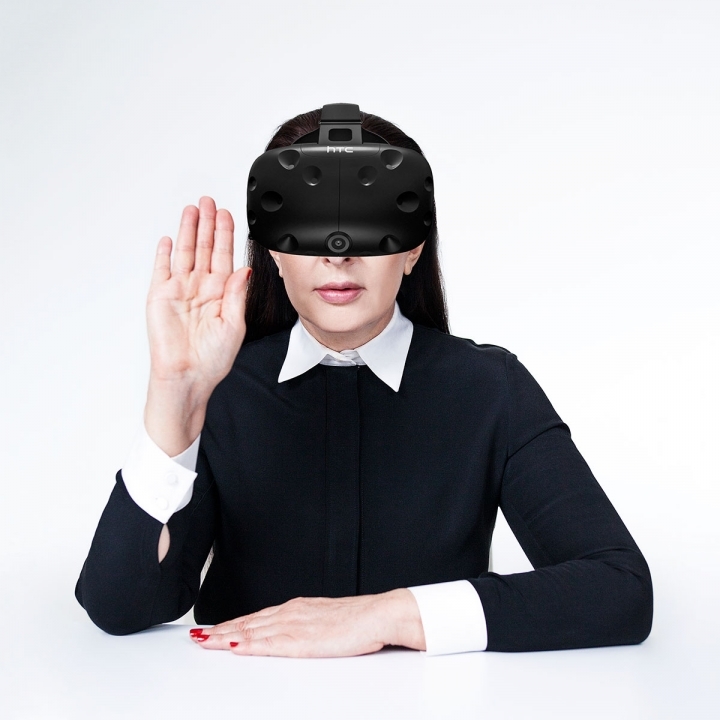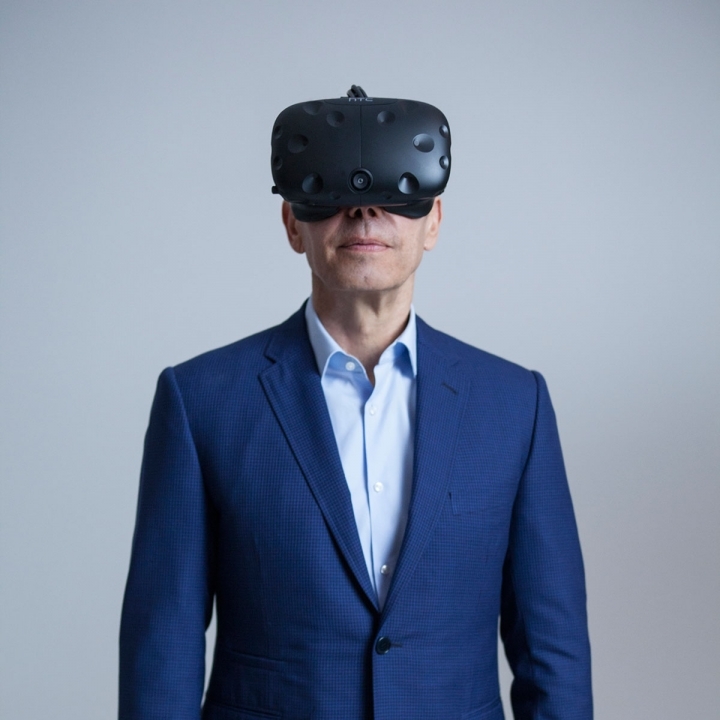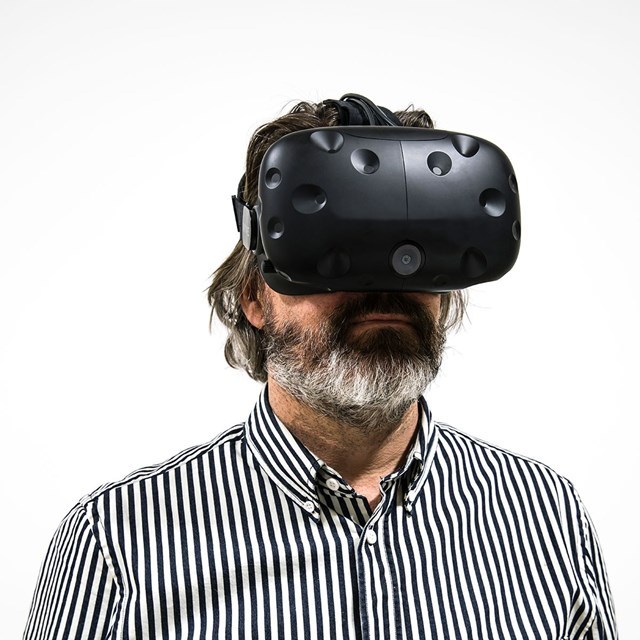This article was originally published by i-D UK.
Virtual reality, as you may have noticed recently, is no longer confined to gags in cartoons in which the not-too-distant-future is imagined. Flying cars, hoverboards and teleportation all remain in the works, but innovation in VR now permeates everything from our health services to the entertainment industries (not to mention the inevitable marketing co-opt by brands). But despite the possibility for innovation in the art world, there haven’t been many examples of artists making significant, positive waves with VR.
Jon Rafman got London talking with Sculpture Garden (Hedge Maze) at the Zabludowicz Collection in 2015, an exhibition that used an Oculus Rift headset to send the viewer through a disorienting maze that blurred the lines between imagined situations and actual experiences. Jordan Wolfson‘s Real Violence took things a significant step further at this year’s Whitney Biennial, confronting viewers with the highly uncomfortable scene of a man being brutally beaten with a baseball bat. The piece came with an age restriction and trigger warning, and was labelled “disturbing” and “horrifying” by many who experienced it.
But limitations in the technology and the reality of financial constraints have meant both the creation and the ability to experience such work has been difficult. Now, the door is being opened by a new VR platform looking to bridge the gap, named Acute Art. The three small, up-and-coming artists Acute has enlisted to launch the programme? Marina Abramovic, Jeff Koons and Olafur Eliasson.
The trio of contemporary artists debuted their work for Acute at Brilliant Minds, a leadership conference that forms part of Stockholm Symposium, an annual festival in the Swedish capital celebrating the intersection of culture and technology. While none of their respective works came with content warnings, all three played with themes of affirmation and the empowerment of the viewer, pushing the boundaries of VR in different directions, and embodying each artist’s unique approach to art, design and performance.
The platform, which has more internationally renowned artists lined up to create bespoke pieces in the coming months, intends to launch to the public in autumn, allowing everyone with a smartphone to experience these pieces. After presenting their work, we got the three artists’ thoughts on virtual reality art, and the impact of technology on creativity.

Marina Abramovic
Given the political and bodily nature of Marina’s work, it seems only natural for the grandmother of performance art to use herself as a way of confronting the viewer in a digital realm.
“[Technology is] extremely dangerous… more dangerous than we can possibly think,” Marina said after presenting her piece, Rising. “If you just think of the kids who got hooked on computers, just sitting there all day long. The worst thing about virtual reality is that the brain starts taking what you see as real, and then you start living in this non-real world, in this altered reality.”
Hoping to utilise the tool for good instead of evil, Rising uses the platform to draw attention to the dangers of climate change. Putting the VR headset on, the viewer is met by Marina several feet ahead, immersed in a tank of rapidly rising water.
We love bad stuff, we love to kill other human beings, so that’s the problem.
Inspired by a video game she played 20 years ago in Japan, in which “an orphanage is burning and you’re the fireman saving the children,”the aim of Rising is direct; to save Marina from drowning you must pledge to protect the environment. Ignore the problem, and she will die. “After that, I never saw any video game so positive. I really wanted to make something positive.”
Place the palms of your hands on Marina’s against the walls of the glass tank, and you’re transported to the rapidly melting Arctic, exposed to the devastation our actions are causing to the polar ice caps. Does she think this can galvanise people to make changes?
“We all agree that there’s bad aspects and good aspects [to technology], of course the three of us are all trying to do something good. But we are much more addicted to bad things than good things. We love bad stuff, we love to kill other human beings, so that’s the problem.”

Jeff Koons
“Artists throughout history have always embraced new technologies,” Jeff explained, when asked about engaging audiences with these new technological advancements. “Whether it’s oil paint, or pigment, or the different tools to work with.” Sending a less overt call-to-action than Marina’s, though utilising the power of the virtual space just as effectively, Jeff’s piece is political in its commentary on the world around us and the way we engage with it.
It’s wonderful that people can pick up a phone and feel the freedom of creativity.
Phryne — pronounced ‘Fry-nee’ — drops you into a beautiful, floral and tranquil garden. Phryne herself is a metallic ballerina, created in the image of one of Jeff’s famous inflatable statues, and named after the most beautiful woman in ancient Greece. Phryne stands a few feet away upon entering his VR world. As you approach her, she encircles you, elegantly dancing around on her tiptoes. Should you be lucky enough to meet her gaze, she offers you a chance to enter a new portal inside her. Conveying ‘grace, harmony and the universal pastoral,’ Phryne intends to relieve the participant of anxiety, allowing you to interact with the garden, and the butterflies that fly around you.
So what does Jeff, one of the world’s most formidable artists, think about this new digital revolution? “I think technology has informed us so much, it’s let us appreciate other works of art. I think it’s wonderful that people can, you know, pick up a phone and feel the freedom of creativity — like Snapchat — making something that is aesthetically and emotionally pleasing, and fun, and to just feel that experience.”

Olafur Eliasson
Danish-Icelandic artist Olafur Eliasson’s work arguably translates most naturally to the virtual realm, as he’s always been interested in creating environments that blur between the natural and artificial.
If I can do a rainbow then I can do anything.
For Acute, he’s generated a digital rainbow, viewable only from certain angles when wearing the VR headset. Water falls on the user in all-different colours, but can only be experienced when stood in the right position, much as a rainbow can only be viewed from certain angles in real life. Unlike the previous two works, Olafur’s piece allows for multiple users to experience this at once, playing on his interest in the intersection of space and self.
“I was very curious about what would be the hardest thing. Making a rainbow, which is what nature does. So I came to the rainbow just because I thought I’m going to make it so difficult… if I can do a rainbow then I can do anything.” Using ‘Newtonian science’ to bring the multi-coloured rainbow to life, programming it so that each raindrop hits the light at a certain degree, Olafur has created perhaps the most visceral experience of all three, closing the gap between real and digital to dramatic effect.
“I think it’s really great because we came up with three really different pieces,” Marina closes with. Did they know what the other was working on when they were making their own? “No. They kept us absolutely in the dark. 600 page contracts!”
Read: “Bad art is what’s kept in the castle toilet” – We asked Grayson Perry to explain art.
Credits
Text Ryan White
